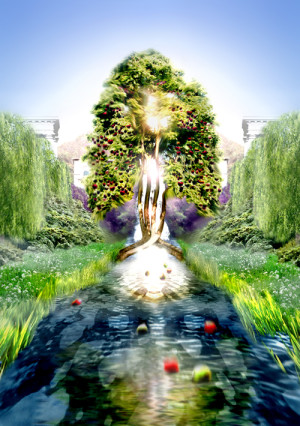 The many features that could never be created by man divulges the timing of the temple’s construction under the Messiah’s kingship. Nevertheless, some imagine that this temple was an offer only for Israel in Ezekiel’s day, and has no future fulfillment. The deniers have no excuse, for there is an element that is so marvelous that it must be recognized as coming about only by the presence of the Messiah: a river of life flowing from the temple in Ezekiel 47:1-12.
The many features that could never be created by man divulges the timing of the temple’s construction under the Messiah’s kingship. Nevertheless, some imagine that this temple was an offer only for Israel in Ezekiel’s day, and has no future fulfillment. The deniers have no excuse, for there is an element that is so marvelous that it must be recognized as coming about only by the presence of the Messiah: a river of life flowing from the temple in Ezekiel 47:1-12.
The valley formed by the splitting of the Mount of Olives at the return of Jesus (Zech. 14:4) allows for the flow of an amazing river that will exist during the Millennium. The river’s fountainhead will be in the house of the LORD (Joel 3:18). Specifically, it will flow from below the temple’s threshold facing the east (v. 1). The river begins as only a trickle of water on the south side (v. 2). As it flows eastward the river will become progressively deeper. The river’s depth builds from ankle-deep to knee-deep to waist-deep until it finally becomes so wide and deep that a man could swim in it but be unable to ford. These four deviations are measured in sets of 1,750 feet (vv. 2-5). In total, they represent the distance from Jerusalem to the eastern slope of the Mount of Olives.
The river actually flows in two directions; to the eastern sea (the Dead Sea) and to the western sea (the Mediterranean) (Zech. 14:8). The result is a sort of double-river. Wherever the waters flow there will be life as a result (v. 9). Ezekiel 47:9 more literally translated reads: And wherever the two rivers go… Therefore, while most of the Biblical narrative covers the eastern side of the river, the nature of the western side can also be inferred.
Several species of fruit trees will grow alongside the banks of the millennial river. These trees will never fail to produce vibrant fruit. A different species will be grown every month. In addition, the leaves of the trees will never wither and will be used for medicine (vv. 7, 12). The abilities of these trees mark them as unlike anything that has grown since the fall of man. They are the direct result of the river that flows from the sanctuary (v. 12).
The millennial river has such an inherent healing effect that that Dead Sea will require a name change. Ezekiel 47:8-11:
And he said to me, “This water flows toward the eastern region and goes down into the Arabah, and enters the sea; when the water flows into the sea, the water will become fresh. And wherever the river goes, every living creature that swarms will live, and there will be very many fish. For this water goes there, that the waters of the sea may become fresh; so everything will live where the river goes. Fisherman will stand beside the sea. From Engedi to Eneglaim it will be a place for the spreading of nets. Its fish will be of very many kinds, like fish of the Great Sea. But its swamps and marshes will not become fresh.
The river will pour into the Arabah[1] and will make fresh what was once among the saltiest bodies of water on the earth (v. 8). At present, the Dead Sea is so inhospitable that only a few forms of microorganisms can survive in it. The Hebrew Yam ha Maved strictly translated reads killer sea. The sea means death to any fish unfortunate enough find his way into the water. However, when the healing powers of the millennial river cascade into the Arabah the status quo is bound to change. Wherever the river goes there will be life and an abundance of fish (v. 9), including what will then become the living sea. It is of no great mystery as to why the psalmist says that this river will make the city of God glad (Ps. 46:4). The river will pass through Engedi and Eneglaim,[2] for men will spread their nets to catch fish from these respective locations (v. 10). There will be so many fish caught representing so many species that for the purposes of fishing the Dead Sea will become like the Mediterranean (v. 10).
In contrast to these changes, there will be left some swamps and marshes that will not become fresh (v. 11). The remaining salted areas are indicative of the transitional nature of the Millennium. The saltiness of the Dead Sea can rightly be understood to symbolize death. Even with Jesus reigning from David’s Throne there will still be death, though it be diminished (Is. 65:20). Great improvements will have been made but perfection is yet to be found after the Millennium and in the Eternal State.
Indeed, the millennial river itself serves as a fine example of something that is in a transitional stage. The river continues to exist in the Eternal State but is improved beyond its already impressive character. The two sides of the river may very well be a restoration of the Pishon and Gihon rivers from Eden (cf. Gen. 2:10-11, 13). In the New Jerusalem there is a river, clear as crystal, flowing from the Lamb’s throne (Rev. 22:1). This is the perfected version of the water coming from under the threshold of the Temple (Ezek. 47:1, Joel 3:18). In the New Jerusalem there is no temple, for the Lord God and the Lamb are the archetype of the various temples (John 2:21; Rev. 21:22). The Lamb’s river flows down the middle of the street and on each side there are trees of life bearing twelve kinds of fruit every month. Just like the millennial river, the Lamb’s river will too produce trees that grow leaves for healing. However, the trees growing along the Lamb’s river are each referred to as the tree of life (Rev. 22:2). This is no minor distinction as to eat from such a tree results in eternal life (Gen. 3:22). It is possible that the trees on the banks of the millennial river are also trees of life, though the text is silent. Regardless, the millennial river will be upgraded or replaced by one that is far superior. Both rivers may serve as physical reminders of the spiritual water that Jesus offers (John 4:10-14).
[1] The Arabah is the hollow depression that extends from the Sea of Galilee to the Gulf of Aqabah.
[2] The location of Eneglaim is unknown, though it likely rests somewhere near Qumran on the northwestern shore of the Dead Sea.

Thank you for your research. It has blessed my soul
Thank you for this explanation.
My joy brother.